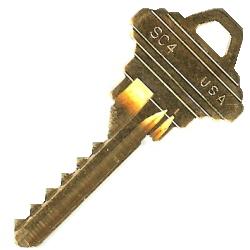There are certain situations that make it a good idea to change or re-key a lock. For instance, when you move into a new home, when your roommate has moved out, after a divorce, when you have lost your keys, or when your keys and locks become worn or faulty. But, how do you determine whether it is better to replace the lock entirely or if it can be re-keyed?
To understand which is best, it’s important to understand what rekeying actually entails. Rekeying should only be done on locks that are in good working order already. Basically, the inside working mechanisms will be changed out to be new and require a new key, leaving the outside hardware in tact. This often means a huge cost savings as opposed to changing and replacing the entire locking system. Though, sometimes replacing the lock is the only or best option.
When you re-key a lock, the locksmith will remove the pins inside the lock and replace them with new pins that can be opened using a brand new key. This is a good option when you are sure that someone stole your keys or know that someone has access to your house at any time uninvited. The safe option is to re-key the lock when you are sure someone else has possession to your keys that unlock your door, and you do not trust this person.
The locksmith removes the pins and springs in the lock cylinder and replaces them with new pins and springs that work with a new and different key. Unless a lock is not functioning properly or a completely new style of lock is wanted by the home owner, several locks are able to be rekeyed and kept in working condition for a long time. Some even claim their rekeyed lock operates even better than ever.
To get technical, the locksmith will remove the pins and springs inside the lock cylinder and replace them with new ones leaving the outside hardware, door knobs and such, in tact. A qualified, experienced locksmith will be able to quickly determine whether or not a rekeying or a lock replacement is your best choice.
Control The Spares
The most common reason to re-key a lock is to regain control of the spares. Simply put, gaining control of the spares merely means accounting for all of the keys that have been duplicated and made to operate the locks. Once you give a key to a friend or family member, the key control is lost. Rekeying also gives you brand new spare keys that you can control as to who has access to your locks. You not only have the peace of mind knowing no one else has a duplicate key, but you now have fresh spare keys that you can tuck away in a secure place only you know about or give to someone you know you can trust so that you can easily and quickly access it if you ever lose your keys again.
Sometimes, in an apartment complex or condominium, keys are created on a master key system. This means, the landlord has ultimate control over who has what keys. But, even in these scenarios, a key could get in the wrong hands. Plus, you always know that the landlord has a key to enter your premises at any time. Though, whenever you change locks out or re-key them in a leased property, you will probably need to obtain landlord consent first.
However, the master key concept is still at play in many single-build communities. The locks are often construction master keyed. This means that while the use of your key may prevent the future use of a contractor’s key, there are often master pins left in the lock. Each master pin is going to double the number of keys that will operate the lock. Often, there are as many as 16 different keys that could open a single home’s locks. Rekeying eliminates the potential of another key opening the lock since rekeying removes these master pins.
Problem With The Locks
Before you lose your keys, you may not have noticed any issues with the locks they once opened. During the rekeying process, the experienced locksmith will identify any other problems that the lock may have and will often be able to fix these issues. This is all done as part of the rekeying process and is nothing you probably would have ever noticed. When the rekeying is done, your lock will be left in a much safer and efficient functioning condition.
When Should You Replace and Change The Locks Entirely
Rekeying is not always the best solution. Sometimes, under certain scenarios, it is better to just go ahead and change out the entire locking system by replacing the lock instead of the more budget-friendly alternative of rekeying. One case that would warrant a lock replacement is when the lock hardware is worn out or beginning to show a great deal of wear and tear and cannot be repaired. In this case, you will need to find a trustworthy locksmith to install a new lock for you.
Another reason you might choose to replace your lock instead of merely rekeying it is when you need to upgrade your security. Do this by upgrading the lock. You might even decide you want an electronic lock. Either situation will mean that the existing locks will need to be completely changed out and replaced rather than rekeying them.
Some lock manufactures offer a lock that the consumer can re-key themselves. These locks are not the standard pin tumbler locks. To allow rekeying of these locks without fully disassembling them entails working with a lot of extra intricate parts that are easier to bypass than traditional locks and can lead to malfunction.
When you need your locks rekeyed or changed out and replaced, be sure to consult a reliable locksmith nearby who will know the best option for you to pursue and will be able to give you a price quote for the hardware and labor. While rekeying is usually the most cost-effective option in terms of saving money, you may have no other choice but to improve your security measures by replacing the entire lock. While the latter choice may be pricey upfront, it will be well worth it in the end.

 Bump keys work with pin tumbler locks, so to understand exactly how a bump key works, you must first understand how a pin tumbler lock functions. Pin tumbler locks are made up of:
Bump keys work with pin tumbler locks, so to understand exactly how a bump key works, you must first understand how a pin tumbler lock functions. Pin tumbler locks are made up of: